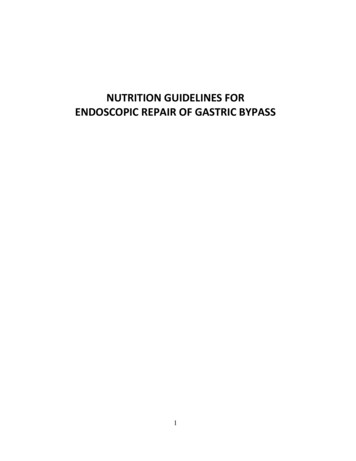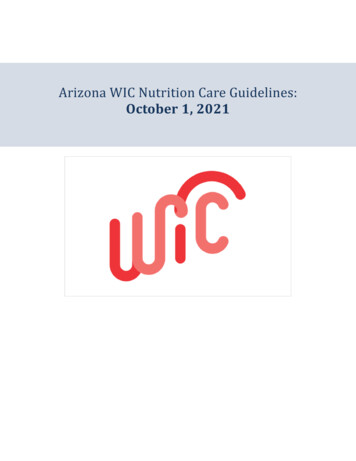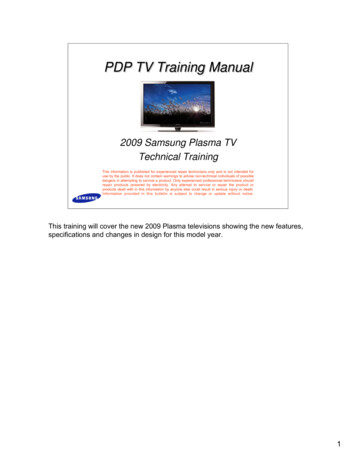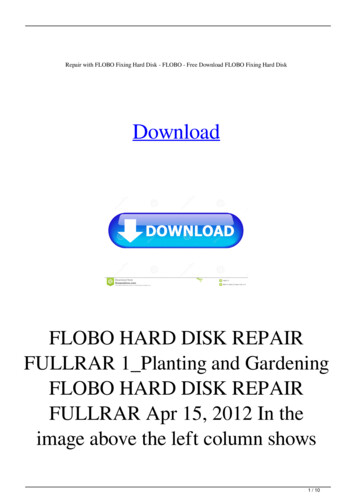
Transcription
NUTRITION GUIDELINES FORENDOSCOPIC REPAIR OF GASTRIC BYPASS1
BEFORE YOUR PROCEDUREAll medications should be converted to either liquid or crushable taken with 1 tablespoon of applesauce. Ask your prescribingphysician to make this change. We cannot change your prescriptions. You may return to your normal form of medicationswhen you begin the soft foods portion of the dietIf you are undergoing a suturing procedure, you will need an Anesthesia Pre-operative appointment at the Weiner Center.Contact information for questions:General GI Clinic: 617-732-6389Dietitian Phone Line: 617-732-8884Typical Dietitian Appointment ScheduleIndividual appointments are 30 minutes.Before Surgery: Nutrition Assessment Nutrition Follow-Ups as neededAfter Surgery 2 weeks 6 weeks 3 months 6 months 1 yearAfter 1 year, meet with dietitian twice per year (every 6 months) forever2
Skills for SuccessEndoscopic bariatric surgery is only a tool. You must commit to a healthy lifestyle (diet, exercise, behaviors) tostay successful forever.FluidsChoose sugar-free, non-carbonated fluids.Sip fluids throughout the day, aiming for 48-64 ounces.Know the signs of dehydration: headaches, dizziness, dark urine. Nocaffeine until stage 4.Avoid alcohol 6-12 months after surgery.Eating BehaviorsTake bites the size of a dime.Chew, chew, chew; puree the food with your teeth.Wait between bites to see how your stomach feels.Aim for 30-40 minute meals.Make Eating MindfulAvoid grazing, nibbling, and picking throughout the day.Have regularly scheduled eating events.When you’re eating, just eat! Avoid distractions. Eatoff a smaller plate.Separate Fluids from SolidsWait to drink fluids until 30 minutes after you eat solid food. It’sokay to drink before eating.Why? Eating and drinking at the same time can overfill yourstomach and make you feel sick.Plan AheadLife is busy now and it will be busy after surgery too. Youwill make healthier choices when you plan ahead.Chop/peel ingredients in advance and meal prep.Pack food and fluids for busy days.Bring your own food to social events if you aren’t surewhat will be served.Stay AccountableTrack yourself: food and beverage choices, exercise, and weight are goodplaces to start.Keep your appointments with the CMBS team.Let your support team know how they can help you stay on track.3
Dumping SyndromeDumping syndrome is the body’s reaction to eating and drinking foods and beverages with added sugar, such as cakes,cookies, candies, juice, and soda. The foods or beverages pass too quickly through the stomach pouch. This causessymptoms such as nausea, cramping, cold sweats, dizziness, extreme tiredness, and an increase in heart rate. Usuallythe symptoms will stop in 1-2 hours. Lying down can help patients to recover. Eating high-fat foods, such as fried foods,causes similar symptoms.All patients are encouraged to avoid foods and beverages with added sugar and high-fat foods.Getting Ready for SurgeryWhat to Buy Before SurgeryMeasuring Cups & SpoonsProtein Shakes*Food ScaleVitamin & Mineral Supplements*Sugar-free FluidsPersonal scale for regular, at home, weightchecks*Choose protein shakes and vitamin & mineral supplements from the shopping guides.4
STAGE 1: Nothing to Eat or DrinkBegin:Day of ProcedureDuration:12-24hrsFluid goal:32 to 48 ouncesInstructions:Patient should avoid all oral intake until the following daySTAGE 2: Water and Sugar Free Clear LiquidsBegin:Morning after procedureDuration:1 dayDiet instructions: Fluids are the number one priority 2 ounces of non-caloric, non-carbonated, non-caffeinated liquids every hour for the first6 hours Then 4oz per hour for the next 8 hours . Record all fluid intake Use 1 ounce medicine cup and take 1 sip every 5mins Sip slowly and stop as soon as you feel full Do not use strawFluid options: Water Crystal light Propel Fitness Water or G2 Bouillon or broth Fruit2O Decaffeinated coffee or tea (Diet Snapple) “Flat” decaffeinated diet soft drink or diet ginger ale Diet Jell-O Sugar – free popsicle (less than 20 calories each – limit 2-3 per day)5
STAGE 3: PROTEIN SHAKESBegin:48 hours after procedureDuration:45 daysFluid Goal:60 ounces per day(protein drinks do NOT count towards fluid goal)Protein Goal:60 grams per dayCalorie Goal:900 – 1000 calories per dayVitamins:TWO chewable multivitamins (children’s or adult) Centrum adult or children’s complete chewable Flintstone’s complete chewable plus additional 500mcgVitamin B12 dailyORTWO tablespoons of liquid multivitamin Centrum liquidCalcium Supplement with Vitamin D 1200 – 1500mg per day Maximum 500 mg per dose Calcium Citrate is preferred due to better absorptionDO NOT take the multivitamin and calcium at the same time takingtogether may interfere with each other’s absorptionDiet instructions: Record all fluid intake Use 1 ounce medicine cup and take 1 sip every 5mins Do not exceed 8 ounces per hour Sip slowly and stop as soon as you feel full Do not use straw Avoid gulping, it introduces air into your system and may cause gas pains Plan ahead and have the protein drinks ready to drink Do not drink with meals Fluids are the number one priority: It is VERY important that you stay hydrated6
STAGE 3: PROTEIN SHAKES (CONTINUED)Fluid options: All from Stage 2 Water Crystal light Propel Fitness Water or G2 Bouillon or broth Fruit2O Decaffeinated coffee or tea (Diet Snapple) “Flat” decaffeinated diet soft drink or diet ginger ale Sugar – free popsicle (less than 20 calories each – limit 2-3 per day)Sample Meal Plan:8am8oz Protein drink – 100-150cal9am8oz Water or low calorie beverage10am8oz Protein drink – 100-150cal11am8oz Water or low calorie beverage12pm8oz Protein drink – 100-150cal1pm8oz Water or low calorie beverage2pm8oz Protein drink – 100-150cal3pm8oz Water or low calorie beverage4pm8oz Protein drink – 100-150cal5pm8oz Water or low calorie beverage6pm8oz Protein drink – 100-150cal7pm8oz Water or low calorie beverage8pm8oz Protein drink – 100-150cal9pm8oz Water or low calorie beverageGuidelines for High Protein Supplement: Calories: 150-200cal/serving Protein: minimum of 15gm/serving Sugar: maximum of 10gm/serving A typical protein shake is 8-11 ounces If you are using a protein powder, remember to add the protein, calories, and sugarfrom the liquid you are mixing with.o Example: 8 ounces of skim milk has: 8 grams of protein, 90 calories, 12 grams ofsugar, and 12 grams of carbohydrates7
STAGE 3: PROTEIN SHAKES (CONTINUED)Here is where you will find these numbers:Lactose Intolerance:Lactose is the natural sugar in milk. Sometimes after surgery, your body cannot digestthis sugar. This causes problems like nausea, cramping, bloating, gas, and/or diarrhea. Itis not normal to have these problems from drinking protein shakes. You might beexperiencing lactose intolerance.What if you are experiencing lactose intolerance? Stop drinking protein shakes for 24 hours. Keep drinking your fluids. When you start drinking protein shakes again, avoid any shakes that have milk,‘whey protein concentrate,’ or ‘milk protein concentrate’ in the ingredient list. Instead, choose a protein shake that is made from ‘whey protein isolate.’ Thelactose has been filtered out of whey protein isolate. Call your dietitian if you need help finding lactose-free options.8
STAGE 3: PROTEIN SHAKES (CONTINUED)Other problems related to Protein Shakes?If the taste is bothering you: Flavor your shakes with extracts. You can find extracts in the baking aisle at thegrocery store. You onlyneed a couple drops so go slowly and taste-test along the way. Flavor your shakes with sugar-free syrups. You can find sugar-free syrups at thegrocery store but you will have more flavor options if you order online. Commonbrands are Da Vinci Gourmet and Torani. Flavor your shakes with spices such as cinnamon, ginger, nutmeg, and cloves. Flavor your shakes with unsweetened cocoa powder or powdered peanutbutter; limit to 1 tablespoon total per day.If the smell is bothering you: Drink your shake from a bottle with a small opening. Drink your shake using a straw. Drink your shake at a very cold temperature.If you need to chew: Pour your protein shake into a popsicle or ice cube tray and freeze to make aprotein popsicle. Semi-freeze your protein shake or blend it with ice to make a slushy.Stage 3 Key Points: Be aware of signs of dehydration: sudden lightheadedness or dizziness,headaches, and urine color becoming darker throughout the day. If you’re struggling to tolerate fluids, it’s helpful to try different temperatures foryour beverages. Some patients prefer ice cold while others prefer roomtemperature or warmer beverages. You can try warming up a protein shake up to140 degrees; think “hot chocolate” or look for chicken and tomato soup flavoredprotein (see the Protein Shake Shopping Guide for more details). Keep track of the amount of protein shakes and fluids that you are drinking using afood log. If you cannot finish a protein shake in a 1 hour period, you can save it forthe next meal time and log the amount you drank.Changes in bowel regimens, such as less frequent movements or loose stools, are normal. If youare having discomfort, contact the endoscopic bariatric team or refer to page 22 fortroubleshooting tips and solutions.9
STAGE 3: PROTEIN SHAKES (CONTINUED)Protein drink options: Isopure – 40gm protein (liquid beverage), 25gm protein (1 scoop powder) Liquacel – 16gm protein, 0gm sugar (available at Target) Gelatein – 20gm protein, 0gm sugar: in Slim Fast High Protein – 20gm protein, 2gm sugar Premier Protein High Protein Shake – 30gm protein, 1gm sugar Muscle Milk Light – 20gm protein, 0gm sugar EAS Myoplex Lite – 20gm protein, 4gm sugar EAS Advant Edge Carb Control – 17gm protein, 0gm sugar Pure Protein – 35gm protein, 1gm sugar Body Fortress Whey Protein Powder – 30gm protein, 1gm sugar Ensure High Protein – 25gm protein, 5gm sugar Glucerna Hunger Smart Shake –15gm protein, 6gm sugar Optisource – 24gm protein, 0gm sugar Optifast HP – 26gm protein, 10gm sugarHigh Protein Shake optionsGelatein 20 Serving size 4 ozCalories 90Protein 20 gmSugars 0 gmAvailable online onlySix Star Whey Isolate Serving size 8 ozCalories 140Protein 30 gmSugars 0 gmAvailable at Wal-Mart, Target, CVS pharmacy and onlineLiquacel Serving size 4 ozCalories 90Protein 16 gmFat 0g10
Sugar 0gmAvailable online at Target.comMuscle Milk Light Protein Shake Serving Size 8 ozCalories 100Protein 14 gmSugars 6 gmAvailable at Wal-Mart, Target, GNC, Vitamin Shoppe and onlineMuscle Milk Light Protein Powder Serving size 8 ozCalories 100Protein 14 gmSugars 6 gmAvailable at Wal-Mart, Target, GNC, Vitamin Shoppe and onlineOptisource: Very High Protein Drink Serving size 4 oz Calories 100 Protein 12 gm Sugars 0 gm Available online onlyOptifast HP Serving size 8 oCalories 200Protein 26 gmCarbohydrate 10 gmAvailable online onlyGlucerna Hunger Smart Shake Serving Size 11 ozCalories 180Protein 15 gmSugars 6 gmAvailable at Wal-Mart, Target and onlineEnsure Active High Protein11
Serving size 14 ozCalories 210Protein 25 gmSugars 5 gmAvailable at Wal-Mart, Target, Walgreens and onlineBody Fortress Super Advanced Whey Protein Serving Size 1 scoop (50 gm) in 8 ozCalories 200Protein 30 gmSugars 4 gmAvailable at Wal-Mart, Target,Walgreens pharmacy and onlinePure Protein Shake Serving size 11 ozCalories 170Protein 35 gmSugars 1 gmAvailable at Wal-Mart, Target and onlineIsopure Zero Carb Drink Serving size 10ozCalories 80Protein 20gmSugars 0gmAvailable at GNC, Vitamin Shoppe and onlineIsopure Low Carb Protein Powder Serving size 8ozCalories 210Protein 50gmSugars 1gmAvailable at GNC, Vitamin Shoppe and onlinePremier Protein High Protein Shake12
Serving size 11ozCalories 160Protein 30gmSugars 1gmAvailable at Wal-Mart, BJ’s, Costco and onlineEAS Myoplex Lite Serving Size 11ozCalories 170Protein 20gmSugars 4gmAvailable at Wal-Mart, Target, major grocery stores and onlineEAS 100% Whey Protein Serving Size 1 scoop (39gm) in 8oz Calories 150 Protein 26gm Sugars 2gm Available at Wal-Mart, Target, major grocery stores and online13
STAGE 4: SOFT PROTEINSBegin:45 days after procedureDuration:2 weeksFluid Goal:64 ounces (oz)per day of fluids from Stage 2(protein drinks do NOT count towards fluid goal)Protein Goal:60 – 80 grams per dayCalorie Goal:900-1000 calories per dayVitamins:Vitamin B122 chewable vitamins – Flintstones complete plus additional 500mcgDiet instructions: 3 oz of soft, moist protein foods 3 times per day PLUS 1-2 snacks per day Have a protein shake if you are unable to meet your protein needs through soft, solidfood Maintain a food log. Record all oral intake. Eat slowly - 10 minutes per ounce. Use children’s utensils or chopsticks. Take small bites and put utensils down between bites. Remember to chew well, to applesauce consistency. If you feel full, stop eating – continuous overeating can stretch your pouch. Remember itmay take 20 min for your brain to know you ate anything. Do not eat foods and drink any fluids at the same time. Wait at least 30 minutes beforeor after eating a meal to drink anything. Do not use straw Avoid foods that are high in sugar or fat as they may cause dumping syndrome. Marinated meats, boiled meats and the dark meat of chicken tends to be well tolerated Fibrous meats, such as dry turkey, chicken breast or hamburger, can be difficult todigest Do not fry your meats Frying adds calories and can make foods hard to digest Some people may experience dumping with fatty foods14
STAGE 4: SOFT PROTEINS (CONTINUED)Soft Protein Food options: Tomato Cream Soup (made with skim milk) – 8oz: 6gm protein, 90cal Cottage Cheese (low fat) – 4oz (1/2 cup): 13gm protein, 100cal Egg whites/substitute (no vegetables) – 4oz(½ cup): 10gm protein, 100cal Hard-boiled egg white - mashed (no yolk)– 2 large 2oz:6gm protein, 30cal Tuna (canned or fresh in water) – 3oz: 20-22gm protein, 95cal Salmon (canned or fresh) – 3oz: 20-22gm protein, 120-150cal Chicken or Turkey (canned or fresh) – moist, 3oz: 15-18gm protein, 120-150cal Imitation Seafood – 3oz: 10gm protein Tofu – 3oz: 12gm protein, 90calTry to meet the protein goal of 6070 grams each day before choosingfoods from the non-protein list. Yourstomach will fill up quickly from theprotein foods so you might not haveroom for the non-protein foods.How to Count Grams of ProteinThis is a container of Greek yogurt. The label saysthat the serving size is 3/4 cup. That means thateach serving has 13 grams of protein. If you eatthe whole serving, you have eaten 13 grams ofprotein. However, with your small stomach, youmight not have room for the whole serving. If youeat half of the container, you have eaten 6.5grams of protein.15
STAGE 4A: PUREED FOODS AND SEMI-SOLIDSPureed Food Ideas: Pureed/Semi-Solid FoodsType of FoodSTARCHESMashed potatoOatmealFarinaCream of WheatFRUITSApplesauce (unsweetened)Peaches (canned in juice)VEGETABLE( ½ cup whole ¼ cup pureed)Green Beans (canned)Carrots (baby food)Beets (canned)MILKYogurt, nonfatMilk, skim or 1%MEATTuna, canned in waterImitation crab meatCheese, low fat or fat freeCottage cheese, 1% or fat freeEgg, scrambledChicken, pureed (dark meat)Turkey (baby food)FATButterOlive oilMayonnaise, lightAmountProtein(g)Fat(g)Calories½ cup¾ cup¾ cup¾ cup2.04.52.53.34.41.70.10.411110587115½ cup½ cup0.20.80.10.055355¼ cup pureed2.5 oz(2 oz ¼ cup)¼ cup pureed0.80.00.10.013300.80.1268 oz8 oz8800-390-12080-1101 oz(1 can 6 oz)1 oz1 oz1 oz(4 oz ½ cup)1 oz1 oz2.5 oz71403.543.5 10-3 13040-502067864.558072901 teaspoon1 teaspoon1 teaspoon0004.14.6536405016
STAGE 5: SOLID CALORIE DIETStart:2 months postoperativelyDuration:OngoingDiet Instructions: 900 – 1200 calories a day Avoid all high calorie and soft, mushy foods that can easily pass though a dilated gastricpouch or dilated GJ outlet (stoma). Avoid any foods that dissolve in your mouth or do not require chewing i.e. Crackers or pretzels; yogurt or ice cream or soup Avoid all highly refined or processed foods i.e. Protein bars, fast food, frozen meals Avoid condiments i.e. butter, gravy, cream cheese, peanut butter, oil Avoid liquid calories, all beverage should have zero calories Crystal Light, Diet Snapple, Fruit 2O, water, etc are ok to drinkImportant Information: Examples of foods to avoid: Beverages high in calories Fruit juice, fruit smoothie or frappes power drinks, soda, coffee with added cream or sugar Foods that do not require chewing Soups, cottage cheese, yogurt, peanut butter, mashed potato apple sauce, pudding, ice cream Foods that dissolve in your mouth White rice, white bread, crackers, chips, pretzel, cereal Foods that are processed Cookies, protein bar, prepackaged foods, frozen meals Fast food, 100 calorie packs of any kind Do not consume protein shakes unless directed to do so by your physician We encourage you to eat solid, bulky, high fiber, low fat foods.17
STAGE 5: SOLID CALORIE DIET (CONTINUED)Sample Diet:MealBreakfastFood-1 scrambled egg-1 piece whole wheat toast-2 links turkey sausageLiquid8 oz Decafcoffee8 oz waterSnack1 serving fruitChewable Calcium8 oz chSnack2 cups salad greens with non-starchyvegetables4 oz grilled/steamed chicken2 teaspoons oil1 Tablespoon vinegar OR 1 Tablespoonlight dressingHerbs, salt, pepperChewable Multivitamin1 hard boiled eggDinnerSnack8 oz water8 oz water-3 oz grilled/steamed/poached fish-1 cup steamed broccoli-1/3 cup sweet potatoSodium free herbs/seasoningChewable Calcium1 serving fruit8 oz water8 oz water8 oz water64 oz waterTotal18
STAGE 5: SOLID CALORIE DIET (CONTINUED)Variations:Instead of:Use:1 Egg2 turkey sausages1 piece whole wheat toast¼ cup Egg beaters (30 calories, 6 g protein)2 veggie sausages (120 calories, 13 g protein)½ Whole wheat English MuffinBreakfast above1 cup skim milk and ½ cup of steel cut or Irish oatmeal1 serving fruit in AM½ cup grapes1 cup cubed melon1 cup fresh pineapple½ whole pearLunch above3-4 oz meat, fish, or poultry, a non-starchy vegetable,and a starch (rice, pasta, potato)2 teaspoons oil and1 Tablespoon vinegar1 Tablespoon regular salad dressing2 Tablespoons light salad dressing1 hard boiled egg¼ cup boiled edamame (soybeans)Dinner above3-4 oz meat, fish, or poultry, a non-starchy vegetable,and a starch (brown rice, whole grain pasta, bakedpotato)1 cup cooked vegetables2 cups raw vegetables (exclude starchy vegetables, suchas peas, corn, potatoes, lima beans, plantain, squash,and yams)Sample Plate:ProteinEat 1stVegetablesEat 2ndWhole grainsEat 3rd19
VITAMIN AND MINERAL SUPPLEMENTSVitamin and Mineral Supplements:You will need to take vitamin and mineral supplements for the rest of your life after surgery.We recommend that you start with chewable or liquid supplements until stage 4. Over time,if you are comfortable swallowing a ‘petite’ tablet or cutting a pill in half, you can swallowyour supplements.Multivitamin with Minerals: Take a ‘complete’ multivitamin(s) daily; dose will vary based on brand of multivitamin. Complete multivitamins contain iron, zinc, folic acid, and copper. Avoid gummy multivitamins – these don’t have all the right nutrients. Separate multivitamin(s) with iron from calcium by at least 2 hours.Vitamin B12: Take 350-500 micrograms vitamin B12 daily in the form of a tablet or liquid. You can take vitamin B12 at any time or with any other supplements. You can also get vitamin B12 in a nasal spray or injection. Your multivitamin might have enough vitamin B12 in it. This will be listed on yourshopping guide.Calcium Citrate with Vitamin D: Take 1200-1500 mg of calcium citrate daily split into 2-3 doses.o Your body can only absorb 600 mg of calcium at one time.o Check serving size on calcium nutrition facts label to determine how many totake at one time.o Separate calcium doses by at least 4 hours. Separate multivitamin(s) with iron from calcium by at least 2 hours. You can also meet your daily calcium needs from food and supplements. Talk to yourdietitian.Other Supplements:Some patients may need extra vitamins and minerals, such as iron, vitamin D, or Bvitamins. We will check your vitamin and mineral levels regularly through lab tests anddiscuss extra supplements as needed.20
EXERCISE AND PHYSICAL ACTIVITYMost people need to exercise at least 250 minutes (over 4 hours) each week to maintain weightloss. It takes time to build up to that amount of exercise but start where you’re at. You can evenbreak your exercise up into smaller amounts of time during the day. Remember, find an activityyou enjoy!Here are some ideas for increasing your physical activity before and after surgery.* Walk more! You may start walking immediately after surgery. Make exercise a family event. Go for a walk together after dinner or on theweekend. Keep exercise clothes in your car to make sure you will go to the gym. To decrease impact on your joints, try pool exercises, water aerobics, or astationary bicycle.*oPlease refrain from swimming until your first appointment after surgery. Turn up the music and dance. Do yard work, gardening, or household chores that require brisk movement. Check out exercise videos online. Try chair exercises. Check out a new exercise class.Consider using the FITT principle to progress in your physical routine.FrequencyIntensityTimeHow often youHow hard you areHow long are youperform theseexercising.exercising for?exercises.Start with 1-2 timesInstead of restingTry to build up to theper week andbetween exercises, gorecommendedincrease up to 3through an entire setamount of exercise.times per week.of each exercise of theabove routine thenrepeat 2-3 more times!Or, to progress,increase the weight asyou are able.21TypeThis refers to the typeof exercise you do.Try to achieve abalance throughoutyour week of bothaerobic and strengthtraining exercise.
POSSIBLE PROBLEMS AND SOLUTIONSWe don’t expect all of these problems to happen to you but if they do, we want you to knowhow to solve them. It is helpful to keep a record of anything unusual that occurs and what youdid before and after it happened.Dizziness, Headaches, Lightheadedness, Dark Urine (Signs of Dehydration) Drink fluids with electrolytes (like Propel Zero or Powerade Zero). Add salt to your foods. Drink salty bouillon or soup broth.Call the Physician’s Assistant phone line at 617-732-8882 if you are unable to catch up on yourfluids.ConstipationShort-term Solutions Increase your fluids – aim for 64 ounces daily. Try a laxative, such as Milk of Magnesia or Miralax, and take a stool softener up to 3times daily. Try psyllium, a natural soluble fiber.Long-term Solutions Increase your fluids – aim for 64 ounces daily. Increase your fiber intake.o Eat more fruits, vegetables, and whole grains if your diet stage permits.o If you are unable to add more fiber through your diet, try a fibersupplement, such as Benefiber or Metamucil.o Slow and steady is the key to adding fiber to your diet. Start with a smallamount, such as one serving of fiber supplement or one extra serving of foodwith fiber. Stick with that amount for 1-2 weeks before increasing as needed. Stay physically active. Continue taking a stool softener as needed.Diarrhea Limit or avoid foods with lactose. Lactose intolerance can occur after surgery.Please see page 8 for more details. Eat slowly and chew thoroughly. Do not drink fluids with meals. Avoid high sugar, high fat, and spicy foods. Limit the amount of sugar-free products (like sugar-free candies). These productsmay contain sugar alcohols (artificial sweeteners that end with –ol such as malitol,sorbitol, xylitol, etc.) that can cause diarrhea. Limit caffeinated beverages. Try a probiotic supplement – ask your dietitian for suggestions. Try psyllium, a natural soluble fiber.22
POSSIBLE PROBLEMS AND SOLUTIONS (CONTINUED)Nausea and/or Vomiting Tune into your eating behaviors. Take small bites, chew thoroughly and pause after eachbite. Stop eating or drinking at the first sign of fullness, which may feel like pressure in yourupper chest. Stay hydrated. Drink at least 48-64 ounces of fluids. Keep foods tender and moist. Determine whether you might have lactose intolerance (page 8). Avoid eating and drinking at the same time. If these suggestions do not work, or you vomit bright red or dark brown liquid, pleasecall the PA line or your surgeon’s office.Bloating/Gas/Cramping Limit or avoid foods with lactose. Lactose intolerance can occur after surgery.Please see page 8 for more details. Limit or avoid sugar alcohols (artificial sweeteners that end with –ol such asmalitol, sorbitol, xylitol, etc.). Avoid carbonated beverages. If drinking through a straw causes these problems, avoid using one.Heartburn Every person has different food and beverage triggers of heartburn. Make a list ofthe ones that trigger heartburn for you and avoid them. Take your prescribed heartburn medication. Tune into your eating behaviors. Take small bites, chew thoroughly and pause after eachbite. Avoid lying down for 3-4 hours after eating.Hair Loss Hair loss after bariatric surgery is called ‘telogen effluvium’ and generally occursaround 3-6 months. This happens because some of your hair follicles are in restingstage (telogen phase) during the time of surgery, and the stress of significant weightloss can cause that hair to stay in the resting stage. There’s generally not much you can do about hair loss at 3-6 months post-op exceptminimize washing and brushing to prevent extra fallout. If hair loss continues after month 6, speak to your dietitian. It could be related toiron, copper, zinc, or B vitamin deficiencies or not eating enough protein. You can also try Nioxin shampoo.23
POSSIBLE PROBLEMS AND SOLUTIONS (CONTINUED)Dental Health Because you won’t be eating and drinking together after surgery, you may be at ahigher risk for dental carries. Also, acid reflux may damage your teeth, so considerthe following: Swish your mouth out with water/mouth wash (don’t swallow!) and spit aftereating to remove food particles. Floss regularly. Consider brushing 3 times daily. Talk to your dentist about your bariatric surgery, especially if you have acid reflux. Consider adding a 3rd cleaning; instead of every 6 months, schedule a cleaning for every4 months.24
Decaffeinated coffee or tea (Diet Snapple) "Flat" decaffeinated diet soft drink or diet ginger ale Sugar - free popsicle (less than 20 calories each - limit 2-3 per day) Sample Meal Plan: 8am 8oz Protein drink - 100-150cal 9am 8oz Water or low calorie beverage 10am 8oz Protein drink - 100-150cal











